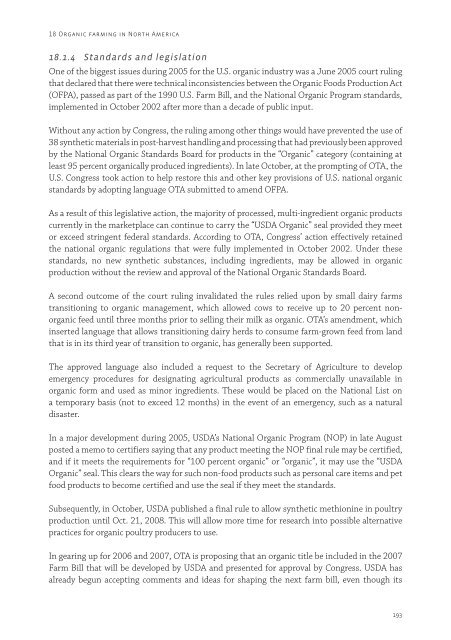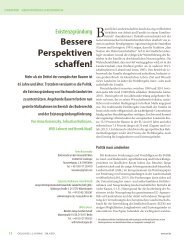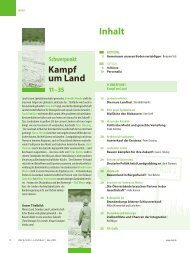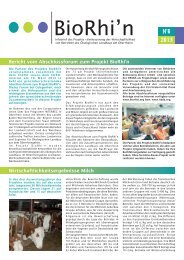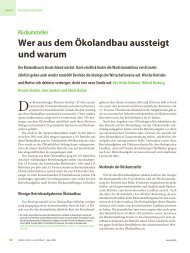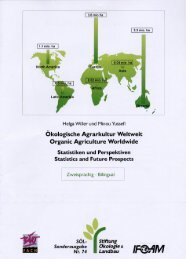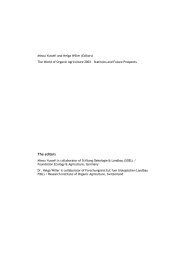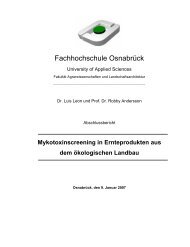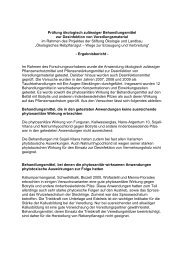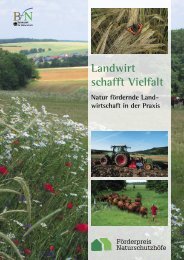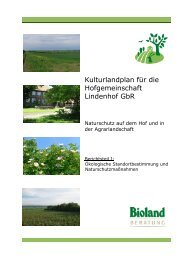the world of organic agriculture - Organic Eprints
the world of organic agriculture - Organic Eprints
the world of organic agriculture - Organic Eprints
Create successful ePaper yourself
Turn your PDF publications into a flip-book with our unique Google optimized e-Paper software.
18 <strong>Organic</strong> farming in North America<br />
18.1.4 Standards and legislation<br />
One <strong>of</strong> <strong>the</strong> biggest issues during 2005 for <strong>the</strong> U.S. <strong>organic</strong> industry was a June 2005 court ruling<br />
that declared that <strong>the</strong>re were technical inconsistencies between <strong>the</strong> <strong>Organic</strong> Foods Production Act<br />
(OFPA), passed as part <strong>of</strong> <strong>the</strong> 1990 U.S. Farm Bill, and <strong>the</strong> National <strong>Organic</strong> Program standards,<br />
implemented in October 2002 after more than a decade <strong>of</strong> public input.<br />
Without any action by Congress, <strong>the</strong> ruling among o<strong>the</strong>r things would have prevented <strong>the</strong> use <strong>of</strong><br />
38 syn<strong>the</strong>tic materials in post-harvest handling and processing that had previously been approved<br />
by <strong>the</strong> National <strong>Organic</strong> Standards Board for products in <strong>the</strong> “<strong>Organic</strong>” category (containing at<br />
least 95 percent <strong>organic</strong>ally produced ingredients). In late October, at <strong>the</strong> prompting <strong>of</strong> OTA, <strong>the</strong><br />
U.S. Congress took action to help restore this and o<strong>the</strong>r key provisions <strong>of</strong> U.S. national <strong>organic</strong><br />
standards by adopting language OTA submitted to amend OFPA.<br />
As a result <strong>of</strong> this legislative action, <strong>the</strong> majority <strong>of</strong> processed, multi-ingredient <strong>organic</strong> products<br />
currently in <strong>the</strong> marketplace can continue to carry <strong>the</strong> “USDA <strong>Organic</strong>” seal provided <strong>the</strong>y meet<br />
or exceed stringent federal standards. According to OTA, Congress’ action effectively retained<br />
<strong>the</strong> national <strong>organic</strong> regulations that were fully implemented in October 2002. Under <strong>the</strong>se<br />
standards, no new syn<strong>the</strong>tic substances, including ingredients, may be allowed in <strong>organic</strong><br />
production without <strong>the</strong> review and approval <strong>of</strong> <strong>the</strong> National <strong>Organic</strong> Standards Board.<br />
A second outcome <strong>of</strong> <strong>the</strong> court ruling invalidated <strong>the</strong> rules relied upon by small dairy farms<br />
transitioning to <strong>organic</strong> management, which allowed cows to receive up to 20 percent non<strong>organic</strong><br />
feed until three months prior to selling <strong>the</strong>ir milk as <strong>organic</strong>. OTA’s amendment, which<br />
inserted language that allows transitioning dairy herds to consume farm-grown feed from land<br />
that is in its third year <strong>of</strong> transition to <strong>organic</strong>, has generally been supported.<br />
The approved language also included a request to <strong>the</strong> Secretary <strong>of</strong> Agriculture to develop<br />
emergency procedures for designating agricultural products as commercially unavailable in<br />
<strong>organic</strong> form and used as minor ingredients. These would be placed on <strong>the</strong> National List on<br />
a temporary basis (not to exceed 12 months) in <strong>the</strong> event <strong>of</strong> an emergency, such as a natural<br />
disaster.<br />
In a major development during 2005, USDA’s National <strong>Organic</strong> Program (NOP) in late August<br />
posted a memo to certifiers saying that any product meeting <strong>the</strong> NOP final rule may be certified,<br />
and if it meets <strong>the</strong> requirements for “100 percent <strong>organic</strong>” or “<strong>organic</strong>”, it may use <strong>the</strong> “USDA<br />
<strong>Organic</strong>” seal. This clears <strong>the</strong> way for such non-food products such as personal care items and pet<br />
food products to become certified and use <strong>the</strong> seal if <strong>the</strong>y meet <strong>the</strong> standards.<br />
Subsequently, in October, USDA published a final rule to allow syn<strong>the</strong>tic methionine in poultry<br />
production until Oct. 21, 2008. This will allow more time for research into possible alternative<br />
practices for <strong>organic</strong> poultry producers to use.<br />
In gearing up for 2006 and 2007, OTA is proposing that an <strong>organic</strong> title be included in <strong>the</strong> 2007<br />
Farm Bill that will be developed by USDA and presented for approval by Congress. USDA has<br />
already begun accepting comments and ideas for shaping <strong>the</strong> next farm bill, even though its<br />
193


